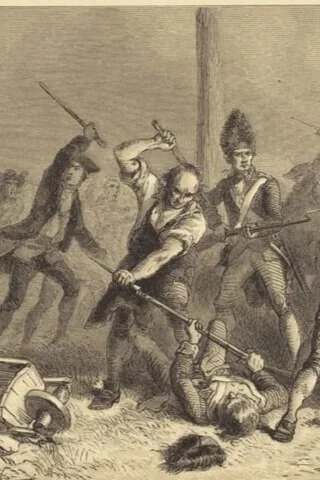“God is Forgotten, and the Soldier Slighted”: New York City’s Golden Hill and Nassau Street Riots and the Affective Rhetorics of Crowd Violence
By Russell L. Weber
Winter’s chill clutched New York City the morning of January 19, 1770. Such unwelcoming weather might have persuaded some New Yorkers to remain indoors, supply their stoves with more kindling, and delay their trip to the market until warmth returned to either their bones or their city. The soldiers of Britain’s 16th Regiment of Foot, however, ignored January’s harsh bite. As these regulars made the half-mile walk from their barracks to Fly Market, their enraged, boiling blood kept them warm.
Read MoreNew Amsterdam and Old New York: Remnants of Netherlandic Architecture in Late-17th Century New York City
By Jeroen van den Hurk
On the afternoon of Monday, June 7, 1697, Dr. Benjamin Bullivant set out from Boston on a trip down the East Coast that would take him all the way down to New Castle, Delaware, and back. The exact reason for his travel is unknown, but he carried with him various letters of introduction for dignitaries he would meet along the way. He also kept a travel diary in which he recorded notes on the built environment he saw in New York City, some of which he considered old and some of which he labeled new.
Read MoreThe World That Fear Made: Interview with Jason T. Sharples
Interviewed by Madeline Lafuse
Today on the blog, Madeline Lafuse speaks with Jason T. Sharples, author of the recently published The World That Fear Made : Slave Revolts and Conspiracy Scares in Early America, about how the fear of slave conspiracies shaped New York City and early America.
Read MoreMyles Cooper and “the Din of War”
By Christopher F. Minty
Rev. Charles Inglis was distraught. “I cannot express the Distress I felt at hearing of your Embarkation for England, & the Cause of it,” he wrote. It was June 1775 and Myles Cooper, his close friend and colleague, had recently departed Manhattan for Britain. Cooper, one of the city’s most prominent and outspoken loyalists, and had long been targeted by revolutionaries. Just a few months before, he was among five New Yorkers who were warned in a April 25, 1775 letter from “Three Millions” that Parliament’s “Repeated insults and unparalleled oppressions” had reduced colonial Americans “to a state of desperation.”
Read MoreMonuments of Colonial New York: George III and Liberty Poles
Wendy Bellion and Shira Lurie
For the last installment in our six-part series on monuments in / about colonial Gotham, Wendy Bellion and Shira Lurie discuss NYC’s rebellion against British rule during the volatile decade before the War for Independence. Bellion begins with a story of destruction — the tearing down of the statue of George III in Bowling Green. Lurie tells of construction — the raising of five liberty poles on the Common (present day City Hall Park).
Read MoreA Long and Complex Legacy:
An Interview with Thai Jones on the Columbia University and Slavery Project
Interviewed by Robb K. Haberman
Today on the blog, editor Robb Haberman speaks with Thai Jones, who co-taught the Columbia University and Slavery Seminar in 2020, about the history of slavery and its continuing legacy at King’s College and Columbia University.
Read MoreA Loyalist and His Newspaper in Revolutionary New York
By Joseph M. Adelman
New York in the 1760s was a divided town, riven by local factions as well as imperial politics. Local elections were fiercely contested, as they had been for decades. The imperial crisis didn’t help.
Read MoreThe Gomez Family and Atlantic Patterns in the Development of New York's Jewish Community
By Noah L. Gelfand
On November 1, 1750, Mordecai Gomez, a member of one of North America’s most prominent Jewish mercantile families, died in New York City. According to a notice a few days later in the New-York Gazette, or Weekly Post-Boy, the sixty-two year old Gomez was “esteemed a fair Trader, and charitable to the Poor” who passed away “with an unblemish’d Character;” and who would be “deservedly lamented” by his large family and all his acquaintances.
Read MoreRevolutionary Networks: The Business and Politics of Printing the News, 1763-1789
Reviewed by Jonathan W. Wilson
Have pity for John Holt. He lived in perilous times. As the publisher of the New-York Journal, and as a centrally located postmaster, Holt was poised to play an important role in the American Revolution. His evident sympathies were with the patriots. But he had to be careful.
Read More





